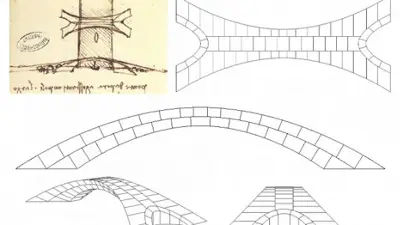|
Leonardo's 500-year-old Bridge Crosses Digital Divide
October 13, 2019 In the same way that physicists keep proving hunches and predictions by Albert Einstein correct decades after his death, a group of researchers have proven workable a 500-year-old bridge design by Renaissance Man Leonardo Da Vinci. 
Leonardo, at the behest of Sultan Bayezid II of the Ottoman Empire, had in 1502 submitted a proposal for the design of a bridge to connect Istanbul (then Constantinople) to its neighboring city Galata, across a river estuary known as the Golden Horn. Leonardo didn't win that contract, but he did outline a bridge concept that, like many other things in his famous Notebooks, were ahead of their time. Leonardo's design called for a 918-foot-long bridge, which would have been the longest bridge in the world at that time. A bridge of such length would, using techniques in use at the time, have required supports in the form of semicircular arches and at least 10 piers, the researchers said. Leonardo, however, proposed one flattened arch, which would have been tall enough for a sailboat, mast and all, to sail through underneath. Leonardo also included elements of safety, to protect against the all-too-common earthquakes that rattled the region. Part of the design was a set of wing walls, or smaller walls attached to the abutments at the ends of the bridge, to help stabilize it. 
Heading up the group of researchers at the Massachusetts Institute of Technology was recent graduate student Karly Bast, who worked with an undergraduate, Michelle Xie, and a staff member, Professor of Architecture and Civil and Environmental Engineering John Ochsendorf, to put Leonardo's concept proof to the reality test. They pored through the pages of Manuscript L, a small work that contained Leonardo's sketches of the bridge concept and his letters to the Sultan describing it. They quickly realized that they didn't have the money to build a bridge that size, so they opted for a model. Also, they chose to use 3D printers to generate the building materials, taking care to use only materials that would have been available to 16th-Century civil engineers. The model was 32 inches long, 500 times smaller than Leonardo's original design; the researchers printed 126 blocks, each of which took six hours to produce, then assembled them into a model bridge. They used a set of scaffolding to build the bridge, then removed the scaffolding once all of the blocks were in place. The bridge provided its own support. |
Social Studies for Kids |
Social Studies for Kids
copyright 2002–2024
David White




